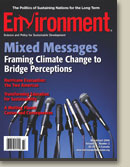At Environment, How to Sell A New Climate Policy

Last night in his State of the Union address, Obama asked Congress to send him a bill that caps carbon emissions, with the president framing the matter primarily in the context of economic recovery and energy innovation:
“But to truly transform our economy, protect our security, and save our planet from the ravages of climate change, we need to ultimately make clean, renewable energy the profitable kind of energy. So I ask this Congress to send me legislation that places a market-based cap on carbon pollution and drives the production of more renewable energy in America. And to support that innovation, we will invest fifteen billion dollars a year to develop technologies like wind power and solar power; advanced biofuels, clean coal, and more fuel-efficient cars and trucks built right here in America.”
Obama’s speech is a promising sign. As I write in a paper just out at the journal Environment, the strategic framing of the problem by the President and his allies will be a central driver of any legislation. Indeed, absent a successful public communication campaign, Obama’s climate policy proposals will suffer the same fate as past president’s efforts at heath care reform and immigration reform.
As I conclude in the paper, one pitfall for Obama to avoid is the same catastrophe narrative that Gore and other environmentalists have previously used. As Andrew Revkin observes in today’s NY Times and as I comment in his article, this message strategy may mobilize a base of support but it is unlikely to generate widespread public engagement on the issue. In fact, it opens Gore and the President to the paralyzing counter charge of “global warming alarmism.”
Another frame to avoid is the same type of “war on science” and “restoring science to its rightful place” rhetoric that was used on the campaign trail and in the early days of Obama’s administration.
While during the Bush era this public accountability frame justifiably mobilized liberals and many scientists, now that Obama is in office the same message likely alienates Republican segments of the public that the president desperately needs to rally around climate action. The frame provides the heuristic that science is for Democrats and not for Republicans and focuses on conflict rather than consensus. (See end note #44 in the Environmentarticle for more on the strategic influence of the “war” metaphor in policy debates.)
So what are alternative frames and strategies that are likely to work? As I describe in the paper, one is to focus on energy innovation, but a second includes emphasizing the moral and religious imperative to take action. In this direction, White House strategists can take lessons from scientists link Carl Sagan, E.O. Wilson and Eric Chivian (see also this side bar on “Shared Values Between Scientists and Evangelicals.”)
Once the White House can clear agenda room to make climate change a communication priority, a promising strategy would be to host a religious summit on climate change, perhaps led in part by Evangelical leaders such as Rick Warren and Richard Cizik. The follow up would be to use a diversity of church leaders, church-based networks, and religious media to mobilize support for climate action.
A third frame I spotlight in the paper is to focus on the public health implications of climate change. Obama has yet to name his surgeon general, but imagine CNN’s Sanjay Gupta in that position, combining the authority and prestige of the office with his communication ability.
As Gupta appeared on the TV networks and in a series of national town hall meetings, his message would be backed up at the local level by public health agencies and medical professionals focusing on the connections to respiratory problems, asthma, allergies, heat stroke, and the risk to vulnerable populations such as low income minorities, kids, and the elderly.
As I conclude in the article, these innovative communication strategies that are derived from past research need to be further tailored and tested across different audience segments. With several colleagues, I am currently working on a grant-funded project to do just that and hope to have interesting findings to report back in a few months.




